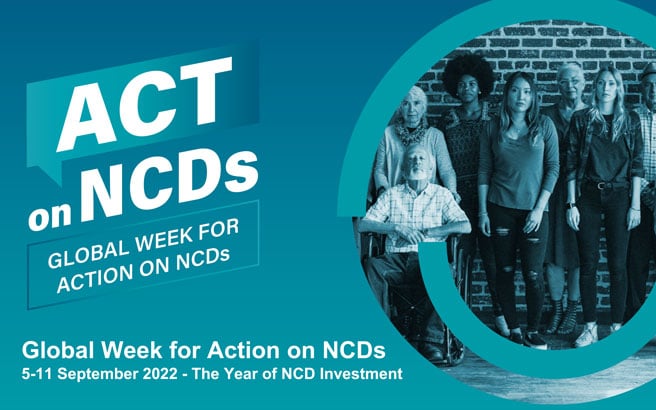It would cost just as little as $1 per person to save many of the people who die from non-communicable diseases (NCDs) every year. These diseases cause 7 out of every 10 deaths worldwide, which could be avoided by additional investment. According to the World Health Organization (WHO), every year 15 million people worldwide die prematurely due to NCDs. However, with the appropriate action to reduce environmental factors that foster unhealthy behaviours and according to the NCD Alliance, 80% of NCD deaths could be prevented or delayed into old age.
NCDs have remained one of the most underfunded global health issues with only 1–2% of total development assistance for health dedicated to NCDs in the past 20 years.
This year, the annual Global Week for Action on NCDs focuses on bridging the investment gap, seeking to ensure NCD prevention and management get the attention and action they deserve.
Spotlight on cancer: prevention saves lives and money
It is estimated that up to 40% of cancers could be prevented. To help reduce the risk, governments can work on a population level to support an environment that minimises exposure to known cancer risk factors. Primary prevention, or the prevention of a cancer developing, is a particularly cost-effective strategy and a life-saving opportunity.
Investing in the fight against non-communicable diseases (NCDs) has never been more important. Cancers could be prevented by addressing the major NCD risk factors – unhealthy diets, inadequate physical inactivity, alcohol and tobacco use – but the lack of resources and investment in NCD prevention – and care – is costing the world millions of lives and dollars each year. For instance, according to the 2019 Global Burden of Disease estimates, action in improving nutrition could prevent one in five premature deaths globally – which include cancer related deaths.
Where are the solutions?
There is plenty of evidence on cost-effective solutions and interventions that can address NCD risk factors. The WHO NCD Best Buys, which have been packaged and endorsed by governments, are affordable, cost-effective and evidence-based NCD interventions described by Forbes this year as big-time bargains. The policies include increasing health taxes and restrictions on marketing and sales of harmful products. They cost on average an additional US$0.84 per year, per person in poorer countries and contribute to social and economic development, with a return on investment of nearly 12:1 for certain interventions, namely healthy diets. On average, they return US$7 for every dollar invested in lower income countries. However, progress on implementing these solutions remains slow and these measures are underutilised.
Making the case for investment
 The case for investing in non-communicable diseases is strong, necessary and urgent. By 2030, implementing the Best Buys could save close to 7 million lives in low- and middle-income countries. When converted into economic and social benefits, these health gains could be worth more than US$ 230 billion – not accounting for healthcare cost savings to governments and individuals, highly underestimating the full health impact. The cost of NCD policy inaction seriously threatens health and prosperity – estimated to cost US$25 per person per year in low-income countries and $50 per person per year in lower middle-income countries.
The case for investing in non-communicable diseases is strong, necessary and urgent. By 2030, implementing the Best Buys could save close to 7 million lives in low- and middle-income countries. When converted into economic and social benefits, these health gains could be worth more than US$ 230 billion – not accounting for healthcare cost savings to governments and individuals, highly underestimating the full health impact. The cost of NCD policy inaction seriously threatens health and prosperity – estimated to cost US$25 per person per year in low-income countries and $50 per person per year in lower middle-income countries.
Investing in NCDs is a no-brainer for donors, development agencies and governments themselves. There is proven evidence on the cost-effectiveness of investing in NCD Best Buys. While there remain questions around financing, there is at least one clear way forward: taxation.
Politically taxing
Raising taxes is an efficient way for governments to reduce consumption of health harming products and raise additional revenue, through increased excise taxes on tobacco, alcohol and sugar. However fiscal measures are underused – for example, only 85 countries have some form of sugar-sweetened beverage tax.
Health taxes work best when implemented as part of a comprehensive policy intervention package. There is a need to connect decisions impacting on NCDs across all government departments such as transport, environment, and agriculture. Improving health by reducing harmful consumption – while saving money at the same time – can also be achieved by shifting investment portfolios to exclude industries that undermine health by selling harmful products aggressively, and interfering in policymaking to prevent governments’ implementation of health-promoting policies. However, policymakers often still shy away from fiscal measures due to misconceptions about their efficacy and acceptability and because of interference by industry.
It’s time that governments step up and reap the huge benefits to the health and wellbeing of their citizens and deliver the much needed and impactful investment that NCD prevention and control demands. The second WHO Global Dialogue on financing national NCD responses in 2023 and the fourth High-Level Meeting of the UN General Assembly on the prevention and control of NCDs in 2025 will be important moments for countries to come together and mobilise more resource and action. WCRF International is proud to support the NCD Alliance and the broader community in calling for more investment into NCDs and be a voice for change.
> For more information about how and why we should increase investment into NCDs, visit actonncds.org

